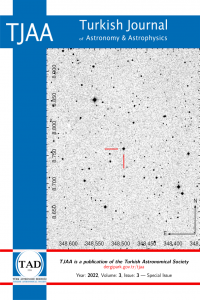Abstract
Bu çaılşmada Gaia uydusunun erken üçüncü veri sürümü (Gaia EDR3) kataloğundaki astrometrik ve fotometrik verilerinden itibaren makine öğrenmesi yöntemiyle keşfedilen ve literatürde detaylı çalışması bulunmayan UPK 51, UPK 350, UPK 579 ve UPK 599 açık kümelerinin Gaia EDR3 ve 2MASS verileri kullanılarak astrometrik ve astrofizik parametreleri tayin edilmiştir. Çalışmada, küme doğrultusundaki yıldızların öz hareket bileşenleri ve trigonometrik paralaksları Gaussian Mixture Modeli (GMM) kullanılarak kümeye üyelik olasılıkları hesaplanmıştır. Kümeye üyelikleri P ≥ 0.5 olan yıldızlardan itibaren UPK 51, UPK 350, UPK 579 ve UPK 599 açık kümelerinin, sırasıyla, sönümlemeleri (AG; 0.12, 0.10, 0.35, 0.10), uzaklıkları (d; 576, 450, 690, 645), ağır element bollukları (Z; 0.015, 0.005, 0.008, 0.010) ve yaşları (log t; 8.20, 8.50, 8.60, 7.30) tayin edilmiştir.
References
- Bressan A., Marigo P., Girardi L., Salasnich B., Dal Cero C., Rubele S., Nanni A., 2012, Monthly Notices of the Royal Astronomical Society, 427, 127.
- Cantat-Gaudin, T., et al., 2020, Astronomy & Astrophysics, 640, A1.Cutri R. M., et al., 2003, 2MASS All Sky Catalog of Point Sources.
- Friel E. D., Janes K. A., Hong L., Lotz J., Tavarez M., 1995, in The Formation of the Milky Way. pp 189–190.
- Frinchaboy P. M., et al., 2013, The Astrophysical Journal, 777, L1.
- Gaia Collaboration et al., 2021, Astronomy & Astrophysics, 649, A1.
- Sim G., Lee S. H., Ann H. B., Kim S., 2019, Journal of Korean Astronomical Society, 52, 145
- Pedregosa F., et al., 2011, Journal of Machine Learning Research, 12, 2825
- Lada C. J., Lada E. A., 2003, Annual Review of Astronomy &Astrophysics, 41, 57-115
- King I., 1962, Astronomical Journal, 67, 471
Abstract
In this study astrometric and astrophysical parameters were determined using Gaia and 2MASS data of UPK 51, UPK 350, UPK 579 and UPK 599 open clusters, which were discovered by machine learning method starting from the astrometric and photometric data in the Gaia Early Data Release 3 (Gaia EDR3). In the study, the cluster membership probabilities were calculated using the Gaussian Mixture Model (GMM) for the proper motion components and trigonometric parallaxes of the stars in the open cluster direction. Beginning from stars with cluster membership probability $P\geq 0.5$, the extinction (${A}_{\rm G}$; 0.12, 0.10, 0.35, 0.10 magnitude), distances ($d$; 576, 450, 690, 645) of open clusters UPK 51, UPK 350, UPK 579 and UPK 599, respectively. parsec), metallicity ($Z$; 0.015, 0.005, 0.008, 0.010) and ages ($\log t$; 8.20, 8.50, 8.60, 7.30 dex) were determined.
References
- Bressan A., Marigo P., Girardi L., Salasnich B., Dal Cero C., Rubele S., Nanni A., 2012, Monthly Notices of the Royal Astronomical Society, 427, 127.
- Cantat-Gaudin, T., et al., 2020, Astronomy & Astrophysics, 640, A1.Cutri R. M., et al., 2003, 2MASS All Sky Catalog of Point Sources.
- Friel E. D., Janes K. A., Hong L., Lotz J., Tavarez M., 1995, in The Formation of the Milky Way. pp 189–190.
- Frinchaboy P. M., et al., 2013, The Astrophysical Journal, 777, L1.
- Gaia Collaboration et al., 2021, Astronomy & Astrophysics, 649, A1.
- Sim G., Lee S. H., Ann H. B., Kim S., 2019, Journal of Korean Astronomical Society, 52, 145
- Pedregosa F., et al., 2011, Journal of Machine Learning Research, 12, 2825
- Lada C. J., Lada E. A., 2003, Annual Review of Astronomy &Astrophysics, 41, 57-115
- King I., 1962, Astronomical Journal, 67, 471
Details
| Primary Language | Turkish |
|---|---|
| Subjects | Astronomical Sciences (Other) |
| Journal Section | Articles |
| Authors | |
| Publication Date | December 31, 2022 |
| Submission Date | December 20, 2021 |
| Acceptance Date | January 20, 2022 |
| Published in Issue | Year 2022 Volume: 3 Issue: 3 |
TJAA is a publication of Turkish Astronomical Society (TAD).

